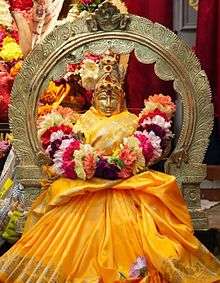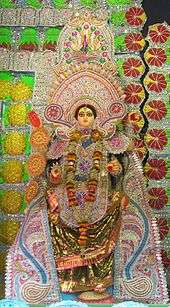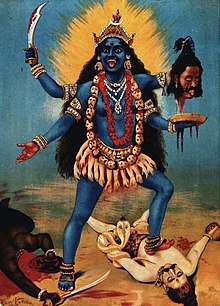Bhuvaneshvari
Bhuvaneshvari (Bhuvaneshwari; Sanskrit: भुवनेश्वरी, Kannada: ಭುವನೇಶ್ವರಿ IAST: Bhuvaneśvarī) is the fourth amongst the ten Mahavidya or Shivasakthi goddesses in Hinduism, and an aspect of Devi as elements of the physical cosmos in giving shape to the creation of the World.
| Bhuvaneshvari | |
|---|---|
The Highest form of Adi Parashakti | |
| Member of The Ten Mahavidyas | |
 | |
| Devanagari | भुवनेश्वरी |
| Sanskrit transliteration | Bhuvaneśvarī |
| Affiliation | Adi Parashakti, Parvati, Shivashakti, Maha Kali, Durga, Uma Haimavati, Mahavidya, Kali |
| Abode | Manidvipa |
| Mantra | II bhūvanēşī mahāmāyā sūryāmandalārūpīnī I I namanī varadhām sūddhām kāmākhyārūpīnī şīva II |
| Weapon | Ankusa |
| Consort | Shiva |
She is also known as Adi Parashakti or Parvati, i.e. one of the earliest forms of Shakti. Her consort is Shiva as Triyambak (Bhuvaneswara).
Etymology
The word Bhuvaneśwari is a compound of the words Bhuvana Iśwari, meaning "Goddess of the world" or "Queen of the universe", where the worlds are the tri-bhuvana or three regions of bhūḥ (Earth), bhuvaḥ (atmosphere) and svaḥ (Heavens).
Legends
During the beginning of time the Tridevas – Brahma, Vishnu and Rudra did not know who they were and what was their purpose. At this time a flying chariot appeared before them, and a heavenly voice directed them to board the chariot. As the Tridevas boarded the chariot and it started flowing with mind's speed and took them to a mysterious place, which was an island of gems surrounded by ocean of nectar and pristine sylvan forests. As they stepped out of the chariot, the Tridevas were transformed into women, much to their astonishment. As they explored the island they came across an Imperial city protected by nine enclosures and guarded by fierce Bhairavas, Matrikas, Kshetrapalas and Dikpalas. As they entered the city they were amazed by its prosperity and soaring infrastructure and finally reached the Imperial Palace known as Chintamanigriha, guarded by Yoginis. For this was Śrīpūra (alias Devipattana), the capital of Devi Bhuvaneshvari, the Empress of Manidvipa, the abode of Adi Parashakti. When they entered the palace they witnessed Devi Bhuvaneshvari, the queen of all worlds.
Her complexion was red. She had three eyes, four arms, braided hair and was clad in red ornaments. She wore a garland of lotuses and Her body was anointed with red sandalwood paste. She held a goad and a noose with Her left hands, while her right hands displayed abhaya and varada mudras. She was decked with ornaments and wore a crown with a digit of crescent moon as crest jewel.
She was seated on the left lap of Trayambaka Bhairava, who was of white complexion, wore white garments and was decked with ornaments. His hair was matted and was decorated by a crescent moon and Ganga. He had five faces each with three-eyes, and four arms, holding a trident and a battle-axe while displaying varada and abhaya mudras.
The Divine Couple was seated on Panchapretasana, a throne which had Paramashiva as plank while Sadashiva, Ishvara, Rudra, Vishnu and Brahma were five legs. They were being served by many Yoginis, some fanning them, some holding mirror, some offering betel leaves flavoured with camphor, some offering a drink made by mixing honey, ghee, wine and coconut water. Some were ready to dress Bhuvaneshvari's hair, some ready to do makeup, some busy stringing garlands while some singing and dancing to entertain Devi.
The Tridevas witnessed millions of universes each with their own Tridevas, in the sheen of Bhuvaneshvari's toe-nail. Some were getting created by Brahma, some getting sustained by Vishnu while others getting annihilated by Rudra.
Bhuvaneshvari enlightened the Tridevas with Her greatness. Trayambaka is Brahman while Bhuvaneshvari is Brahmashakti. Though they appear distinct, both are of the nature of one another. Trayambaka is Adipurusha while Bhuvaneshvari is Mulaprakriti. To help Trayambaka perform his three-fold Lila, Bhuvaneshvari has created three forms of him- Brahma, Vishnu and Rudra. Thus, Tridevas are forms of Trayambaka. Thereafter Bhuvaneshvari gave her shaktis Saraswati to Brahma, Lakshmi to Vishnu and Kali to Rudra and departed them to their respective places.
Brahma with Saraswati created an cosmic egg and Rudra with Uma split it, exposing the Pancha Bhootas. Brahma with Saraswati fashioned the universe from Pancha Bhootas, and Vishnu and Lakshmi sustain it. At the end Rudra with Kali will annihilate the universe so that Brahma and Saraswati can start afresh.
Once, Lord Brahma, Lord Vishnu and Lord Shiva were involved in an argument about who is the most powerful and supreme of the three. Their debate became so intense that it disturbed the peace of the heavens and worried the Gods. That was when the beautiful Goddess stepped in to intervene and cease the dispute. She took the Trinity of Gods to her idyllic abode and led them to her beautiful chamber. There, Goddess Bhuvaneshwari enlightens them that she is the creator of the entire universe as it is created out of her and ends in her. She is responsible for protecting it from devils. She has created many elements and gave life to all the Gods, sages and all living beings.
She had also created many worlds, such as Satyalok, where Lord Brahma lives. It is the most supreme place of all the worlds where the inhabitants are free of life and death cycle. Then Taplok came into being, where the soul, including the body, resides. The inhabitants there wait for Satyalok to take shape. Gyanlok then was formed where the place had the presence of ascetics who were the inhabitants. Maharlok came into being where after the harsh penances, the sages and ascetics have a place to live. The sages who live in that place has the power equal to Gods. That is why all the sages live in that place. Then comes Anandlok, which is Swarglok, which is the residence of Gods and virtuous beings. Next, Bhuvarlok was formed where the sun and planets are positioned. After Bhuvarlok came Bhulok, where mortal and other living beings live.
The worlds beneath Earth came into being, the first being Atal Lok in which it is the home of revelry and all the wealth of the planets in accumulated there. Then came Vital Lok, where the beings of the earth stay there to mine gold and other elements. Just like Atal Lok, Vital Lok is centred on earthly riches. Then through King Bali, the king of demons, Sutal Lok came into being. Talatal Lok came into existence and below that, Mahatal was created in which it is Naaglok, the home of all serpents and snake girls. Further down below is the realm of demons and monsters, named Rasatal. Finally, below all the worlds, then originated Patal Lok where Vasuki, the King of snakes lives. This is the foundation of all the other realms.
Then, Brahma, Vishnu and Mahadev witnessed millions of universes each with their own person, in the sheen of Bhuvaneshwari's toe-nail. Some were getting created by Brahma, some getting sustained by Vishnu while others getting annihilated by Rudra. Bhuvaneshwari enlightened the Tridevas with Her greatness.
Thereafter, Goddess Bhuvaneshwari gave her Shaktis Saraswati to Brahma, Lakshmi to Vishnu, and Gauri to Shiva. She informed Tridev that her Shaktis that they are given to will help them create and preserve the world, and when the appropriate time comes, it will be destroyed completely so that a new creation can be started afresh by Brahma and Saraswati.
Temples

There are several temples dedicated to Bhuvaneshwari across India. In South India most of the Srividhya tradition upasaka worship her. In Kerala she is also popular among Shaktas.
- A Shakti Peetha is located in Nainativu (Manipallavam) – off the shore of the Jaffna Peninsula in Northern Sri Lanka.
She is worshipped as the patron goddess of Bhubaneswar and by Utkala Brahmins of Odisha.
- A Natmandir dedicated to the goddess can be found in Hatkhola Chandannagar where the goddess is worshipped annually for a month in the month of Sravan. Here the image of the goddess is built in traditional Bengali style flanked by Shiva and other gods.
 Annual Bhuvaneshwari Puja at Chandannagar, India (2018)
Annual Bhuvaneshwari Puja at Chandannagar, India (2018) - Another temple dedicated to Bhuvaneshwari is located in Pudukkottai, Tamil Nadu.
- A small shrine is also dedicated to her inside Jagannath Temple, Puri and Devi Subhadra is worshipped as Bhuvaneshwari.
- The Samaleswari shrine and Cuttack Chandi Temple in Odisha two are dedicated to her.
- The oldest temple of Maa Bhuvaneshwari devi is located at Gunja, ta: visnagar, dist: mehsana, north gujarat . Where the function of Mataji’s palli held on the auspicious occasion ( Aatham of Navratri).
- A dedicated temple of Bhuvaneshwari Devi is located at Gondal in Gujarat which was established in 1946.[1]
- Nochipra Bhagavathy-Kshetram temple located at Westhill, Calicut in Kerala is a 900+ years old temple where the main deity is Bhuvaneshwari Amma, the divine mother. Bhuvana Iśwari, meaning "Goddess of the worlds" or "Queen of the universe" where the worlds are the tri-bhuvana or three regions of bhūḥ (earth), bhuvaḥ (atmosphere) and svaḥ (heavens). In this most loved form Bhuvaneshwari Amma becomes the provider and grants everything in abundance to her devotees and is capable of turning any situations per her wishes.
- The Kamakhya Temple houses a Bhuvaneshwari shrine.
- Bhuvaneshvari Amma is also known to be the devate of Karnataka or the kannadamma and the Bhuvaneshvari temple at Historical city of Badami is one of the oldest temple.
- There is a temple dedicated to Bhubaneshwari Devi, situated in the small town of Jamshedpur, at a place called Telco. Locals believe the temple to be quite powerful, and the temple sees devotees making promises of sarees to the Goddess, in return for granting their prayers. A powerful temple of Bhuvaneshwari Amma is situated in choorakkodu, Adoor near Vellakulangara.
- There is a temple dedicated to Bhubaneshwari Devi, situated at the bank of the river Krishna at Bhilawadi in Sangli district of Maharashtra.

In Northern India, Mathura the city of Krishna also has a centuries-old "Bhuvneshwari MahaVidhya" temple just opposite to Krishna Janmbhoomi.
One more Temple in Maharashtra, Shri shetra Audumber, sangli district.
- In Kullu district of Himachal Pradesh, there is a dedicated temple to devi Bhuvneshwari where she is known as Mata Bhuvneshwari Jagannathi and fairs are held there in respect to the deity twice a year.
- At Lingaraj Temple in Bhubaneswar, Odisha, there is a small temple dedicated to Maa Bhuvaneshwari.
In North America, Bhuvaneshwari is worshipped at Parashakthi Temple in Pontiac, Michigan.[2]
In Sydney, Australia, Bhuvaneshwari is worrshipped at Shri Shiva Mandir in Minto, NSW.[3]
See also
- Devi
- Mahavidya
- Pattambalam
- Lingaraj Temple
- Bhuvaneshwari Temple Siddapur, Uttarakannada
References
- Archived 2016-04-27 at the Wayback Machine Images of Bhuvaneshwari temple of Gondal
- "Welcome to Parashakthi (Eternal Mother) Amman Temple, Pontiac, Michigan, USA". Parashakthitemple.org. Archived from the original on 2012-03-26. Retrieved 2012-03-03.
- "Shri Shiva Temple". shrishivamandir.com.au. Retrieved 2020-06-14.
Further reading
- Tantric Yoga and the Wisdom Goddesses by David Frawley
- Hindu Goddesses: Vision of the Divine Feminine in the Hindu Religious Traditions (ISBN 81-208-0379-5) by David Kinsley


